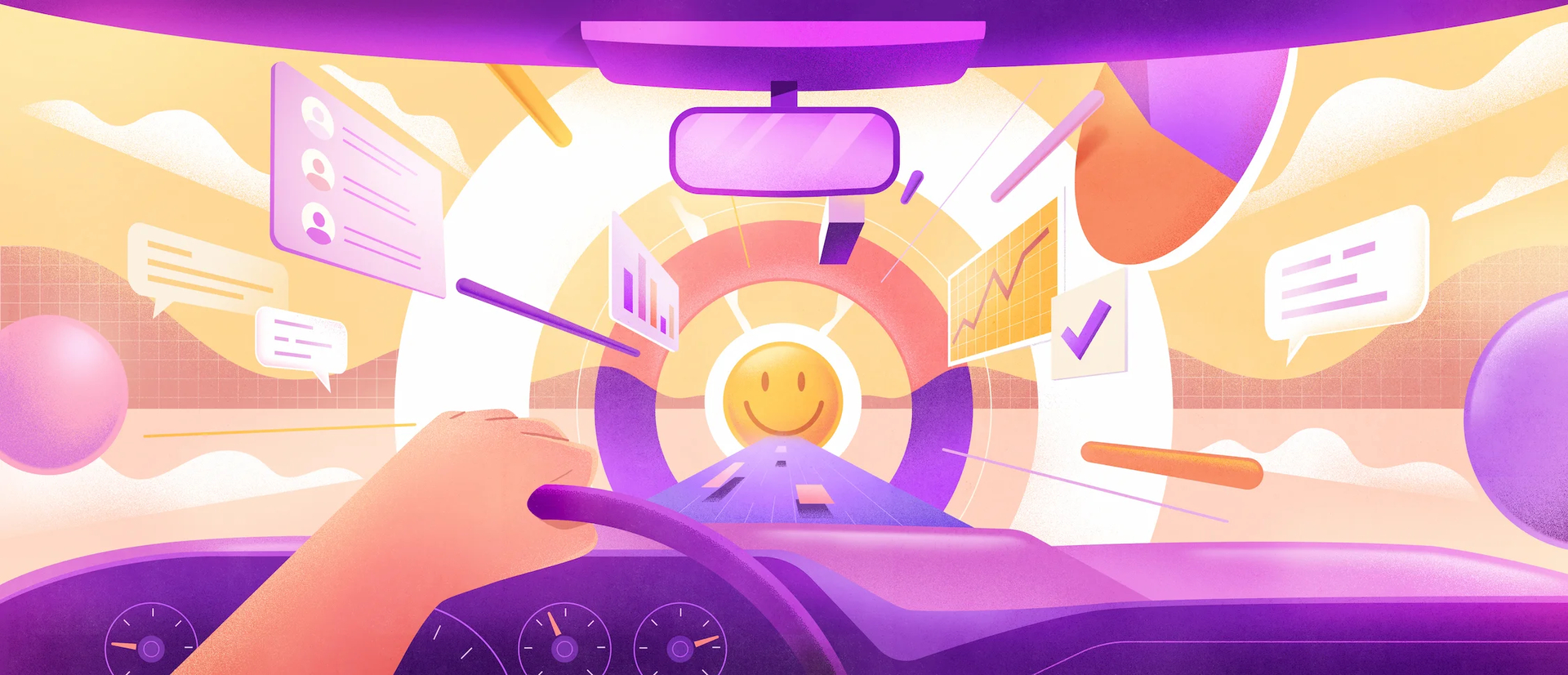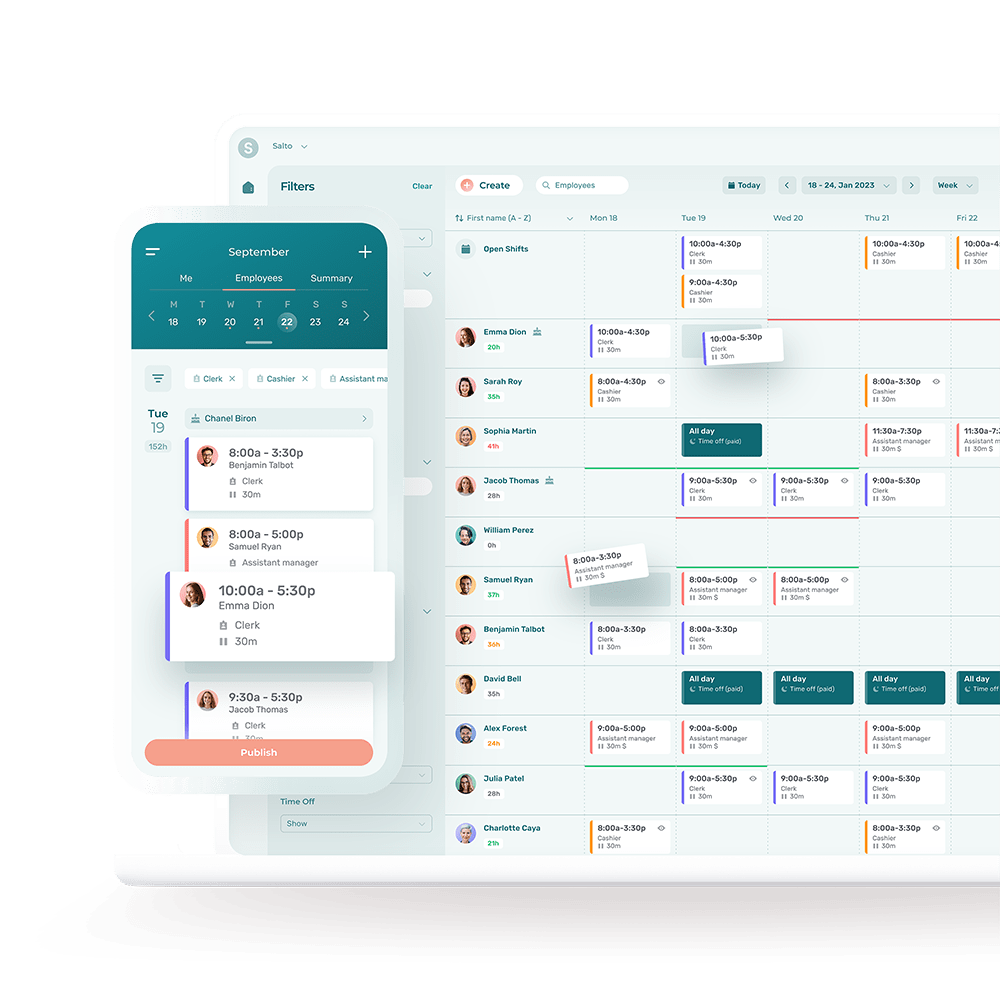A human resources dashboard, or HR dashboard, gives you an overview of the tangible impact of HR decisions within your company.
Among many indicators, it offers insights of HR activities and your staff’s performance.
This powerful tool enables both human resources professionals and managers to continuously improve their practices. In turn, this helps support team members’ well-being and optimize organizational costs.
If I were to tell you that most managers want to improve staff retention, employee engagement, and many other elements tied to staff management…You’d probably agree, right?
So my question is this: How can you truly improve something if you don’t measure it to being with? 🤨
And this is where the HR dashboard comes in—a tool that lets you observe and assess exactly where things stand, so that you can make any necessary changes to correct a situation.
In this article, I’m going to share:
- 4 reasons to track HR indicators for your organization
- 20 key indicators to include in your HR dashboard
- The benefits of automating your HR data
Happy reading!
Why Track HR Indicators?
Tracking HR indicators can influence several areas that are essential to an organization’s performance. For the skeptics out there, let me just say up front that a well-designed and effectively utilized HR dashboard really can improve a company’s practices.
Here are 4 reasons to track your HR indicators:
1. To streamline your day-to-day: track your key HR stages in real time. When it comes to knowing new recruits’ onboarding status, fixing scheduling conflicts, taking care of payroll issues or even highlighting an anniversary, an HR dashboard can make your life so much easier.
2. To check your workload distribution: if one of your employees is constantly overwhelmed with work and has to do overtime, this will inevitably lead to stress and possibly even burnout. Monitoring your team members’ workload helps you take the necessary steps to reduce overload. It also enables you to promote a better work-life balance, which translates into happier employees who will stay with you longer. 😉
3. To measure employee satisfaction: including the results of employee satisfaction surveys in an HR dashboard is a fabulous practice. Regularly tracking employee satisfaction helps you identify issues as they arise and take corrective action. This way, you can kill two birds with one stone and support your employees’ morale as well as their well-being.
4. To better plan team training and skill development: in addition to keeping a closer eye on the dollars your company invests in training, you’ll be able to see at a glance if certain teams are neglecting this important aspect of professional development. You can help along your employees’ well-being by enabling them to develop their skills and advance their careers.
In this way, an HR dashboard can play an important role in improving your employees’ well-being. Do note, however, that this is only one tool (among many others) for doing so.
It’s essential that your organization be proactive and take action on the information you’ve gathered in order to genuinely improve your team’s well-being.
20 Key Indicators for an HR Dashboard
The indicators to include in an HR dashboard will vary according to the specific needs of your organization, industry and goals. That being said, here are a few common indicators that are considered key to human resources management:
Basic HR Indicators
1. Employee numbers: the total number of employees hired by your company, broken down by department, job category, etc.
2. Health and safety: information on your health and safety programs, such as reported incidents and training completed.
3. Budgets: various aspects of your budget, such as projected sales, labor costs, etc.
4. Compensation and benefits: compensation costs, your salary scales (which would benefit of being known by employees, not just management) and benefits—and if you offer bonuses, track them too.
5. Diversity and inclusion statistics: if this is an objective for you, use your HR dashboard to track DEI within your organization. Measure indicators such as the number of women in management positions, the different ethnic backgrounds among your team, the average age of your employees, etc.
6. Internal communications: the latest company communications, including important announcements and information on corporate events, how many employees have viewed them, etc.
HR Indicators Related to Job Satisfaction
7. Turnover rate: this indicator is closely linked to your staff’s level of satisfaction.
If you notice a sudden uptick or downtick from one month to the next, you’ll be in a position to take action.
8. Overall employee satisfaction: satisfaction can be measured using anonymous surveys, and while you’re at it, why not regularly measure your employee net promoter score (eNPS) to help uncover any potential issues?
9. Work anniversaries: you’ll be able to remember your team’s milestones and highlight key moments for the company.
10. Peer recognition: If you encourage recognition at work and are able to measure it (for instance, with employee recognition software), keep an eye on this indicator on a regular basis.
HR Indicators Related to Work Schedules
11. Attendance tracking: track employee attendance in real time: how many employees are at work, how many are on break, and how many are absent or late for their shift?
12. Absenteeism rate: capture your overall absenteeism rate over a specific period. You can compare it from month to month, for example.
13. Analysis of work hours: monitor overtime hours to find out whether you’re within budget and respecting your employees’ break times (and, by the same token, labor standards).
14. Timesheet approvals: are all timesheets from your various branches approved in time for the next payroll? Track this information to avoid errors and delays.
Here’s an example of an HR dashboard in Agendrix:
HR Indicators Dealing With Recruitment
15. Hiring costs: costs associated with recruiting a new employee, including training, onboarding and integration costs, etc.
16. Recruitment cycle: the time it takes to fill a vacancy in your organization. If you have a lengthy recruitment cycle, this can be costly for your company, and you’ll want to find ways to optimize your practices.
17. Internal mobility: does your company allow employees to gradually move up the career ladder? Given that professional development plays a key role in job satisfaction, thus also impacting employee retention, don’t underestimate the power of internal mobility.
HR Performance and Professional Development Indicators
18. Team performance: the key indicators specific to various teams, such as service quality or customer satisfaction, sales, units produced, etc.
19. Individual performance: performance reviews (completed, upcoming, pending), goal achievement, work warnings issued, etc.
20. Training: budgets, hours of training received per employee, mandatory training to renew (e.g., workplace first responder), individual and collective needs to improve skills and performance, etc.
Although these 20 indicators are all valuable, your HR dashboard should first and foremost be clear and practical. So, choose the metrics that are most useful to you, either in your day-to-day or for your company’s overall strategy.
Benefits of Automating Your HR Dashboard
In the age of artificial intelligence, why not lighten the load of your company’s HR reporting by automating your HR data? If you’re already using HR management software, many tasks are probably already automated, such as collecting and updating staff data and managing certain work processes.
Here are some of the benefits of automating your dashboards with HR software:
Integration and Connection With Your Other Software
HR software is generally capable of connecting to a variety of data sources, such as payroll systems, time and attendance software, scheduling software, talent management systems, and more. This ensures that your data is always up to date.
More Detailed Data Analysis
Human resources management tools often offer advanced data analysis and visualization capabilities—providing you with information that’s easier to understand and share.
Data History Retention
HR software keeps track of your HR data, which can be accessed for several years.
In addition to helping you track trends over time, this can help you make decisions based on facts rather than gut feeling alone.
More Advanced Data Security
Compared to an Excel or Word file that anyone could easily access, HR software generally comes with higher levels of security. In a context where the collection and processing of personal data (including on company employees) is becoming an increasingly sensitive topic, you can be a model employer that complies with legislation such as Bill 25 in Quebec and GDPR in Europe.
View Certain Information in Real-Time
HR software lets users view information in real-time—a clear advantage if you want to keep a close eye on your day-to-day operations. At Agendrix, for example, managers can see who is late or absent. Or if the employee they’re looking for on the floor is currently on break. 🫠
Capitalize on Emerging Technologies
Most HR software is ever-evolving—it continues to improve and adapt in step with the changing realities of the job market. This means it can support you as your business grows, for example, with new features, additional task automation, implementation of good practices, and so on.
HR Dashboards at Your Service!
Whether or not you have HR software, why not start tracking certain indicators that make sense for your business? We encourage you to track them over the coming months and use them to make decisions that are more in line with your operations.
Short on inspiration? Here are 5 indicators that might be a good place to start, and links to learn more about each:
What Is an HR Dashboard?
An HR dashboard is a management tool enabling human resources professionals and business managers to track and analyze a variety of data related to employees and staff management at an organization.
It provides a snapshot of HR activities, company performance and the impact of HR decisions.
What Are the Benefits of Tracking HR Data?
Tracking HR data has many benefits for a company, including:
- Informed, data-driven decision-making thanks to stats on your trends and employee performance
- Optimized company performance since you can identify areas for improvement and make adjustments accordingly
- Improved talent retention thanks to staff turnover and employee satisfaction indicators
- More effective recruitment once you know the time required to fill a position, recruitment costs, and the quality of candidates hired
- Better workforce management when you can anticipate staffing needs, such as for busier periods or slowdowns
- Improved employee satisfaction as a result of surveying staff on needs, issues and well-being at work
What HR Data Can Agendrix Track?
The Agendrix dashboard tracks a variety of HR data, including:
- Attendance (employees at work, late or absent employees, employees on break)
- Pending requests (leaves, open shifts, availability)
- Unpublished work schedules
- Schedule conflicts
- Payroll processing
- Budgets
- Employee survey results
- Current onboarding programs
- Recognition messages sent
- Notes for the day
- Upcoming birthdays and work anniversaries












